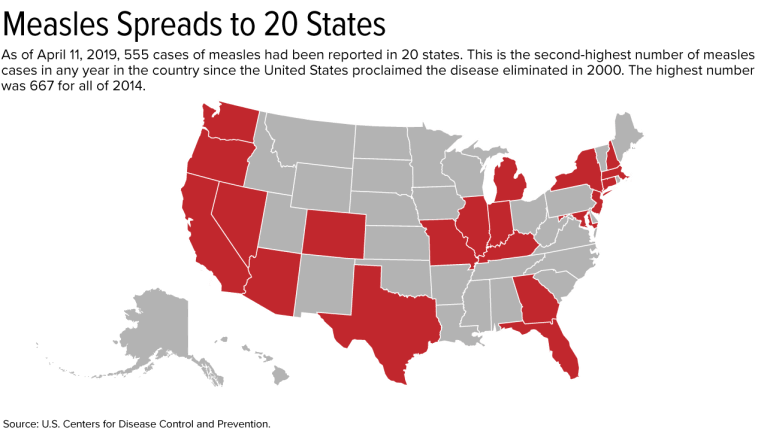How to Respond to the Spread of Measles in the Workplace
How should employers respond to the spread of measles? With measles now at its highest number of cases in one year since 1994, employers are having to cooperate with health departments to fight the spread. Read this blog post from SHRM to learn more.
Employers and educators are cooperating with health departments to fight the spread of measles, now at its highest number of cases in one year since 1994: 764.
Two California universities—California State University, Los Angeles (Cal State LA) and the University of California, Los Angeles (UCLA)—recently quarantined staff and students at the request of local health departments.
In April at Cal State LA, the health department told more than 600 students and employees to stay home after a student with measles entered a university library.
Also last month, UCLA identified and notified more than 500 students, faculty and staff who may have crossed paths with a student who attended class when contagious. The county health department quarantined 119 students and eight faculty members until their immunity was established.
The quarantines ended April 30 at UCLA and May 2 at Cal State LA.
Measles is one of the most contagious viruses; one measles-infected person can give the virus to 18 others. In fact, 90 percent of unvaccinated people exposed to the virus become infected, the U.S. Centers for Disease Control and Prevention (CDC) notes.
Action Steps for Employers
Once an employer learns someone in the workplace has measles, it should immediately send the worker home and tell him or her not to return until cleared by a physician or other qualified health care provider, said Robin Shea, an attorney with Constangy, Brooks, Smith & Prophete in Winston-Salem, N.C.
The employer should then notify the local health department and follow its recommended actions, said Howard Mavity, an attorney with Fisher Phillips in Atlanta. The company may want to inform workers where and when employees might have been exposed. If employees were possibly exposed, the employer may wish to encourage them to verify vaccination or past-exposure status, directing those who are pregnant or immunocompromised to consult with their physicians, he said.
Do not name the person who has measles, cautioned Katherine Dudley Helms, an attorney with Ogletree Deakins in Columbia, S.C. "Even if it is not a disability—and we cannot assume that, as a general rule, it is not—I believe the ADA [Americans with Disabilities Act] confidentiality provisions cover these medical situations, or there are situations where individuals would be covered by HIPAA [Health Insurance Portability and Accountability Act]."
The employer shouldn't identify the person even if he or she has self-identified as having measles, Mavity noted.
Shea said that once the person is at home, the employer should:
- Inform workers about measles, such as symptoms (e.g., dry cough, inflamed eyes, tiny white spots with bluish-white centers on a red background in the mouth, and a skin rash) and incubation period—usually 10 to 12 days, but sometimes as short as seven days or as long as 21 days, according to the CDC.
- Inform employees about how and where to get vaccinations.
- Remind workers that relatives may have been indirectly exposed.
- Explain that measles exposure to employees who are pregnant or who might be pregnant can be harmful or even fatal to an unborn child.
- Explain that anyone born before 1957 is not at risk. The measles vaccine first became available in 1963, so those who were children before the late 1950s are presumed to have been exposed to measles and be immune.
Employers may also want to bring a health care provider onsite to administer vaccines to employees who want or need them, Shea said.
"Be compassionate to the sick employee by offering FMLA [Family and Medical Leave Act] leave and paid-leave benefit options as applicable," she said.
When a Sick Employee Comes to Work Anyway
What if an employee insists on returning to work despite still having the measles?
Mavity said an employer should inform the worker as soon as it learns he or she has the measles to not return until cleared by a physician, and violating this directive could result in discipline, including discharge. A business nevertheless may be reluctant to discipline someone who is overly conscientious, he said. It may opt instead to send the employee home if he or she returns before being given a medical clearance.
The employer shouldn't make someone stay out longer than is required, Helms said. Rely instead on the health care provider's release.
SOURCE: Smith, A. (9 May 2019) "How to Respond to the Spread of Measles in the Workplace" (Web Blog Post). Retrieved from https://www.shrm.org/resourcesandtools/legal-and-compliance/employment-law/pages/how-to-respond-spread-measles-workplace.aspx
4 Simple Reasons Why Texting Can Lead to Better Hires
Are your recruiters continually getting “ghosted” by job candidates? The way they communicate with job recruits may have something to do with why they are getting “ghosted” by candidates. Continue reading for four reasons texting can lead to better hires.
It’s no secret that recruiters spend the majority of their time researching to find the right candidates for the right job, and even more time reaching out to talk to these potential candidates. So it’s natural that they become frustrated when candidates ignore communications like emails and LinkedIn InMail messages from recruiters. While these communication methods can work for some, they definitely aren’t preferred for all — especially these days.
With people busier than ever before, especially passive millennial candidates, recruiters are seeing more and more recruits “ghosting” them. If you are continually getting no responses to your outreach, it likely has something to do with the other 100-plus emails that are hitting candidates’ inboxes every day. Reaching out via SMS (text messaging) can help you break through the noise and make it easy for potential candidates to take the next step.
Here are four simple ways to use text messages to make better hires:
Texting is quicker
In a highly competitive market, speed matters more than ever. How quickly you can secure the talent you need impacts how quickly your business is moving forward. Seventy-three percent of U.S. millennials and Gen Zers interact with each other digitally more than they do in real life. If you want a fast answer, texting is the way to go.
Scheduling via text is also quicker
Nothing good ever comes from never-ending email chains, especially when the topic is as dull as “Are you available Wednesday morning between 9 am and 11 am?” Sending your candidate a link to your favorite scheduling client via SMS puts an end to group-email fatigue and gets the interview on the books in a matter of minutes.
Don’t forget reminders
There’s nothing worse than a candidate showing up late or missing an interview.
A quick text message is a perfect way to give your candidates a quick heads-up, give them an extra tip, a quick pat on the back and send them in ready to win. No one likes tardiness and no-shows. A quick reminder ensures everyone’s on the same page.
Accelerate the hiring process
Text messages make the candidate experience way more enjoyable by simply shortening the hiring process. Hiring typically involves emails, scheduling, and so much admin. A great SMS can make hiring human again, not to mention faster. By communicating directly with someone at a time that works best for them, especially in a way that they’re much more likely to respond quickly, it will help shorten the overall hiring timeline.
When used alongside other awesome tools, such as a chatbot, text messaging could even help qualify leads more quickly and immediately put you in touch with the best candidates.
The bottom line: utilizing text for recruiting can help you revitalize your talent pipeline and create a more engaging candidate experience.
SOURCE: Bounds, D. (25 April 2019) "4 Simple Reasons Why Texting Can Lead to Better Hires" (Web Blog Post). Retrieved from https://hrexecutive.com/4-simple-reasons-why-texting-can-lead-to-better-hires/
What to consider before adding a genetic testing benefit
According to recent statistics from the Society of Human Resource Management (SHRM), 18 percent of employers provide health-related genetic testing benefits. Read this blog post for what employers should consider before adding a genetic testing benefit to their benefits package.
As employers look for new voluntary benefits to help attract and retain employees, a growing number are turning to direct-to-consumer genetic testing for all employees to their benefits plans. According to the latest statistics from the Society for Human Resource Management, 18% of employers provide a health-related genetic testing benefit, an increase of 6% over the previous year.
For the most part, it can be a smart move: Not only can the benefit differentiate one employer from others vying to hire from the same employee pool, genetic testing providers market the benefit as a way to potentially lower healthcare costs and increase employee wellness.
This type of testing can be valuable for employees at an increased risk for certain types of cancer, such as breast and ovarian cancer related to mutations of the BRCA1 and BRCA2 genes, those considering having a child who have risk factors for genetic conditions such as cystic fibrosis and Tay Sachs disease, those who have a family history of conditions like high cholesterol, and those who take medications such as blood thinners and anti-depressants. There also are tests that look for genes associated with conditions such as Parkinson’s disease, Alzheimer’s disease and celiac disease.
But employers also have to realize that genetic testing for all employees, regardless of family history and risk factors, comes with potential downsides. In fact, some physicians believe that widespread genetic testing of this type may even present a risk of harm. There’s also the issue of regulation and oversight of direct-to-consumer genetic testing. The industry is not currently regulated, which, some researchers have found, can lead to inaccurate or varying results. One study found that when the same genetic variant was provided to nine different labs for analysis, the answers provided were different 22% of the time, highlighting the risk of false positive and false negative results.
So for employers who offer — or are considering adding — a genetic benefit, make sure to think about the potential outcomes that can occur by doing so.
The potential for lower costs as well as unnecessary healthcare spending
If an employee’s genetic test is positive for a mutation that’s associated with cancer or another disease, he or she may be more proactive about screening for the disease and may make lifestyle changes that may lower the risk of developing the disease. There are potential healthcare cost savings to early detection of some conditions. For example, by some estimates, the cost for treating early-stage breast cancer is more than 50% less than the cost to treat the same cancer at an advanced stage.
For employees who undergo testing related to how effective a blood thinner or antidepressant will be, there can be better health outcomes as well as cost savings. One study found that when physicians prescribed the blood thinner Warfarin based on pharmacogenomic testing, adverse events decreased by 27%. Avoiding adverse events and making sure employees are taking the medications that can most effectively treat their conditions can help keep them healthy, out of the hospital and productively on the job, all of which has a positive financial impact.
But when you’re screening people who don’t have risk factors or a family history of these conditions, a positive test result can lead to unnecessary testing and medical procedures, potential complications from those procedures and the costs associated with that testing and care.
Before and after testing, education
Employers who offer genetic testing without a physician referral need to take steps to ensure that employees understand the risks and benefits of these tests upfront and that they know what a genetic test can and cannot tell them about their health now and in the future. The first step is for any employer offering genetic testing to provide education for employees.
Many employees don’t realize that having a gene mutation that’s associated with a disease does not mean that he or she will ever develop that disease. The risk associated with most genetic variations is, in fact, relatively small. Because of that misunderstanding, employees may experience needless worry or, if the test is negative for mutations related to a disease, may forgo screenings like mammograms, colonoscopies and cholesterol tests that can help detect health problems earlier when they are often more treatable. In the case of genetic testing for mutations associated with cancer, employees may not be aware that most cancers are not caused by a mutation in the single gene that the test screens for.
For some of the conditions that genetic tests screen for, like Alzheimer’s disease, there are currently no treatments. This can again cause anxiety for employees and their families. Genetic tests also have implications that reach beyond the specific employee who is tested. A positive test can affect siblings and children as well, opening the question of whether the employee wants or feels compelled to share the results with other family members who may also be at risk.
Employers who offer employees genetic testing should ensure that all employees who choose to undergo testing are guided by experienced genetic counselors who can help them interpret and understand the results of their test and can connect them with other healthcare providers for additional testing or treatment as needed.
SOURCE: Varn, M. (3 May 2019) "What to consider before adding a genetic testing benefit" (Web Blog Post). Retrieved from https://www.benefitnews.com/opinion/what-to-consider-before-adding-a-genetic-testing-benefit
4 benefits messages to send employees in May
Tax season has come and gone, and summer is right around the corner, making it a great time of year for employers to beef up communications about certain employee benefits. Read this blog post for four benefits messages employers should send their employees this May.
With tax season behind us, summer right around the corner and the second half of the year coming up, now is a great time of year for employers to beef up communications about certain benefits.
That’s because there are a number of important messages that are specific to this time of year, including saving money for summer vacations and putting more money into a health savings account so employees can plan for healthcare expenses for the remainder of the year.
Here are four messages employers should share with their employers this month.
1. Think about putting more money in your HSA.
May is a great time for your employees to take stock of their healthcare costs from January to April, and plan ahead for the second half of the year. Here’s a breakdown you can send to help them save money and have more cash available through December to pay their bills.
- Add up this year’s out-of-pocket health care costs thus far.
- Make a new estimate of your upcoming expenses (padding that estimate for unexpected expenses that may pop up.).
- Add your estimated costs to what you’ve already spent.
- Compare that total with how much you’ll have in your HSA account at the end of the year as it is now.
- If there’s a gap, you can increase your contribution rate now to make up the difference.
2. Adjust your W-4s.
Tax season has passed, which means it’s an excellent time to…think a little more about taxes.
The tax law changes that went into effect at the start of 2018 might have made your employees’ existing W-4s less accurate. If they didn’t update their withholding amount last year, they might have been surprised by a smaller refund, a balance due, or even by a penalty owed — and chances are, they don’t feel too happy about it.
Let your employees know that they can prevent unexpected surprises like this next tax season with a visit to this IRS tax withholding calculator. There, they can estimate their 2019 taxes and get instructions on how to update their W-4 withholdings to try and avoid any surprises next year. If they can update their W-4 online, send them the link along with clear step-by-step instructions. And if they need to fill out a paper form, explain where to find it and how to submit it.
3. Revisit your budgeting tools.
Summer is almost here, and your employees are likely starting to think about hitting the beach, road-tripping across the country or eating their weight in ice cream. Since having fun costs money, May is a good time to serve up some ideas on how to squirrel away a little extra cash in the next few months.
Employers should share tips for saving money on benefits-related expenses, like encouraging high-deductible health plan employees to use sites like GoodRx.com for cheaper prescription costs, or visiting urgent care instead of the emergency room for non-life-threatening issues. Also, consider making employees aware of apps like Acorns, Robinhood, Stash, Digits and Tally, which round up credit or bank card expenses to the next dollar, and automatically deposit the extra money into different types of savings accounts.
4. Double-check out-of-network coverage.
While you’re on the subject of summer fun, remind your employees to take a quick peek at their health plan’s out-of-network care policies before they head out of town. If they need a doctor (or ice cream headache cure) while they’re away, they’ll know where to go, how to pay, and how to get reimbursed.
Employers should remind employees that their HSA funds never expire, and they’re theirs for life. So if they put in more than they need this year, it will be there for them next year.
SOURCE: Calvin, H. (1 May 2019) "4 benefits messages to send employees in May" (Web Blog Post). Retrieved from https://www.benefitnews.com/list/4-benefits-messages-to-send-employees-in-may
Changes are coming to paid leave. Here’s what employers should know
Many states and local governments are enacting their own paid leave policies, making it difficult for employers to navigate employee paid leave. Read this blog post for what employers should know about the coming changes for paid leave.
A growing number of states and local governments are enacting their own paid leave policies. These new changes can be difficult for employers to navigate if they don’t understand the changes that are happening.
Adding to the confusion among employers, paid sick leave and paid family leave are often used interchangeably, when in fact there are some important distinctions. Paid sick leave is for a shorter time frame than paid family leave and allows eligible employees to care for their own or a family member’s health or preventative care. Paid family leave is more extensive and allows eligible employees to care for their own or a family member’s serious health condition, bond with a new child or to relieve family pressures when someone is called to military service.
The best-known type of employee leave is job-protected leave under the Family Medical Leave Act, where employees can request to take family medical leave for their own or a loved one’s illness, or for military caregiver leave. However, leave under FMLA is unpaid, and in most cases, employees may use available PTO or paid leave time in conjunction with family medical leave.
Rules vary by state, which makes it more difficult for multi-state employers to comply. The following is an overview of some new and changing state and local paid leave laws.
Paid sick leave
The states that currently have paid sick leave laws in place are Arizona, California, Connecticut, Maryland, Massachusetts, New Jersey, Oregon, Rhode Island, Vermont and Washington. There are also numerous local and city laws coming into effect across the country.
In New Jersey, the Paid Sick Leave Act was enacted late last year. It applies to all New Jersey businesses regardless of size; however, public employees, per diem healthcare employees and construction workers employed pursuant to a collective bargaining agreement are exempt. As of February 26, New Jersey employees could begin using accrued leave time, and employees who started after the law was enacted are eligible to begin using accrued leave 120 days after their hire dates.
Michigan’s Paid Medical Leave Act requires employers with 50 or more employees to provide paid leave for personal or family needs as of March.
Under Vermont’s paid sick leave law, this January, the number of paid sick leave hours employees may accrue rose from 24 to 40 hours per year.
In San Antonio, a local paid sick leave ordinance passed last year, but it may not take effect this August. The ordinance mirrors one passed in Austin that has been derailed by legal challenges from the state. Employers in these cities should watch these, closely.
Paid family leave
The five states that currently have paid family leave policies are California, New Jersey, Rhode Island, New York, Washington and the District of Columbia.

New York, Washington and D.C. all have updates coming to their existing legislation, and Massachusetts will launch a new paid family program for employers in that state. In New York, the state’s paid family leave program went into effect in 2018 and included up to eight weeks of paid family leave for covered employees. This year, the paid leave time jumps to 10 weeks. Payroll deductions to fund the program also increased.
Washington’s paid family leave program will begin on January 1, 2020, but withholding for the program started on January 1 of this year. The program will include 12 weeks of paid family leave, 12 weeks of paid medical leave. If employees face multiple events in a year, they may be receive up to 16 weeks, and up to 18 weeks if they experience complications during pregnancy.
The paid family leave program in Massachusetts launches on January 1, 2021, with up to 12 weeks of paid leave to care for a family member or new child, 20 weeks of paid leave for personal medical issues and 26 weeks of leave for an emergency related to a family member’s military deployment. Payroll deductions for the program start on July 1.
The Paid Leave Act of Washington, D.C. will launch next year with eight weeks of parental leave to bond with a new child, six weeks of leave to care for an ill family member with a serious health condition and two weeks of medical leave to care for one’s own serious health condition. On July 1, the district will begin collecting taxes from employers, and paid leave benefits will be administered as of July 1, 2020.
Challenging times ahead
An employer must comply with all state and local sick and family leave laws, and ignorance of a law is not a defense. Employers must navigate different state guidelines and requirements for eligibility no matter how complex, including multi-state employers and companies with employees working remotely in different jurisdictions.
These state paid leave programs are funded by taxes, but employers must cover the costs of managing the work of employees who are out on leave. While generous paid leave policies can help employers attract talent, they simply don’t make sense for all companies. For example, it can be difficult for low-margin businesses to manage their workforces effectively when employees can take an extended paid leave.
Not only must employers ensure compliance with state and local rules, but they also must make sure that their sick time, family and parental leave policies are non-discriminatory and consistent with federal laws and regulations. That’s a lot to administer.
Employers should expect to see the changes in paid sick leave and family leave laws to continue. In the meantime, companies should make sure they have the people and internal processes in place right now to track these changes and ensure compliance across the board.
SOURCE: Starkman, J.; Johnson, D. (2 May 2019) "Changes are coming to paid leave. Here’s what employers should know" (Web Blog Post). Retrieved from https://www.benefitnews.com/opinion/what-employers-need-to-know-about-changing-paid-leave-laws?brief=00000152-14a7-d1cc-a5fa-7cffccf00000
Employers Must Report 2017 and 2018 EEO-1 Pay Data
The Equal Employment Opportunity Commission (EEOC) is requiring that all employers report their pay data, broken down by race, sex and ethnicity, from 2017 and 2018 by September 30. Continue reading this post from the SHRM to learn more.
The Equal Employment Opportunity Commission (EEOC) has announced that employers must report pay data, broken down by race, sex and ethnicity, from 2017 and 2018 payrolls. The pay data reports are due Sept. 30.
Employers had been waiting to learn what pay data they would need to file—if any at all—as litigation on the matter ensued. A federal judge initially ordered the EEOC to collect employee pay data for 2018. The National Women's Law Center (NWLC) and other plaintiffs wanted the EEOC to collect two years of data, as the agency was supposed to under a new regulation before the government halted the collection in 2017.
Judge Tanya Chutkan of the U.S. District Court for the District of Columbia sided with the plaintiffs and gave the EEOC the option of collecting 2017 pay data along with the 2018 information by the Sept. 30 deadline or collecting 2019 pay data during the 2020 reporting period. The EEOC opted to collect the 2017 data.
The agency said it could make the collection portal available to employers by mid-July and would provide information and training to employers prior to that date.
Immediate Steps
"We are awaiting confirmation from the EEOC or the contractor it is hiring to facilitate the pay-data collection on how to lay out the data file for a batch upload," said Alissa Horvitz, an attorney with Roffman Horvitz in McLean, Va.
But employers should take some steps immediately. They should reach out to their subject-matter and technical experts and pull together resources to ensure that the required data components can be captured, analyzed and reported by Sept. 30, said Annette Tyman, an attorney with Seyfarth Shaw in Chicago.
Filing the additional reports will impose unanticipated burdens for HR, IT and legal departments, as well as third-party consultants, she noted. "It is unclear whether any further litigation options will impact the Sept. 30 deadline, and we are instructing employers to assume they must comply."
Employers should keep in mind that they still must submit their 2018 data for Component 1 of the EEO-1 form by May 31, unless they request an extension. Note that the EEOC recently shortened the extension period for employers to report Component 1 data from 30 days to two weeks. So the extension deadline is now June 14.
Component 1 asks for the number of employees who work for the business by job category, race, ethnicity and sex. Component 2 data—which includes hours worked and pay information from employees' W-2 forms by race, ethnicity and sex—is the subject of the legal dispute.
Data Collection
Businesses with at least 100 employees and federal contractors with at least 50 employees and a contract with the federal government of $50,000 or more must file the EEO-1 form. The EEOC uses information about the number of women and minorities companies employ to support civil rights enforcement and analyze employment patterns, according to the agency.
The revised EEO-1 form will require employers to report wage information from Box 1 of the W-2 form and total hours worked for all employees by race, ethnicity and sex within 12 proposed pay bands.
The reported hours worked should show actual hours worked by nonexempt employees and an estimated 20 hours per week for part-time exempt employees and 40 hours per week for full-time exempt employees.
"Filling out the added data in the EEO-1 form will present a large amount of work, especially as there's great potential for human error when populating the significantly expanded form," said Arthur Tacchino, J.D., chief innovation officer at SyncStream Solutions, which provides workplace compliance solutions.
Employers should start looking at their data now and conduct an initial assessment of their systems, said Camille Olson, an attorney with Seyfarth Shaw in Chicago. Identify the systems that house the relevant demographic, pay and hours-worked data and determine how to pull the information together, she said.
Pulling EEO-1 data is much simpler for Component 1, she noted, because it only involves reporting the employer's headcount by race, ethnicity and sex—whereas collecting pay information involves more data points. Additionally, employers may use different vendor systems at different locations, some employees may have only worked for part of the year, and other employees may have been reclassified to exempt or nonexempt.
"Employers may want to inquire with their current vendors—payroll or otherwise—or look for outside vendors that may be able to assist them with this reporting requirement," Tacchino said.
Under some circumstances, employers may be able to seek an exemption (at the EEOC's discretion) if filing the information would cause an undue burden. "Mega employers" may not be able to show an undue burden, but this could be an option for smaller businesses, said Jim Paretti, an attorney with Littler in Washington, D.C. But that will depend on how the parties decide to move forward.
The Court Battle
The EEO-1 form was revised during President Barack Obama's administration to add the Component 2 data, but the pay-data provisions were suspended in 2017 by President Donald Trump's administration. The NWLC challenged the Trump administration's hold on the pay-data collection provisions, and on March 4, Chutkan lifted the stay—meaning the federal government needed to start collecting the information.
On March 18, however, the EEOC opened the portal for employers to submit EEO-1 reports without including the pay-data questions. Chutkan subsequently told the government to come up with a plan.
The EEOC proposed the Sept. 30 deadline for employers to submit Component 2 data, claiming that the agency needed more time to address the associated collection challenges. Furthermore, the EEOC's chief data officer warned that rushing the data collection may yield poor quality data. Even with the additional time, the agency said it would need to spend more than $3 million to hire a contractor to provide the appropriate procedures and systems.
Robin Thurston, an attorney with Democracy Forward and counsel for the plaintiffs, said at an April 16 hearing that the plaintiffs don't want the agency to compromise quality. But they also wanted "sufficient assurances" that the EEOC will collect the data by Sept. 30.
On April 25, Chutkan ordered the government to provide the court and the plaintiffs with periodic updates on the EEOC's progress and to continue collection efforts until a certain threshold of employer responses has been received.
SOURCE: Nagele-Piazza, L. (2 May 2019) "Employers Must Report 2017 and 2018 EEO-1 Pay Data" (Web Blog Post). Retrieved from https://www.shrm.org/resourcesandtools/legal-and-compliance/employment-law/pages/eeo-1-pay-data-report-2017-2018.aspx
Can Employers Require Measles Vaccines?
Can employers require that their employees get the measles vaccine? The recent measles outbreak is raising the question of whether employers can require that their workers get the vaccine. Read this blog post from SHRM to learn more.
The recent measles outbreak, resulting in mandatory vaccinations in parts of New York City, raises the question of whether employers can require that workers get the vaccine to protect against measles, mumps and rubella (MMR) or prove immunity from the illness.
The answer generally is no, but there are exceptions.
Offices and manufacturers probably can't require vaccination or proof of immunity because the Americans with Disabilities Act (ADA) generally prohibits medical examinations—unless the employer is in a location like Williamsburg, the neighborhood in Brooklyn where vaccinations are now mandatory. Health care providers, schools and nursing homes, however, probably can require them because their employees work with patients, children and people with weak immune systems who risk health complications from measles.
But even these employers must try to find accommodations for workers who object to vaccines for a religious reason or because of a disability that puts them at risk if they're vaccinated, such as having a weak immune system.
Proof of Immunity
Proof of immunity includes one of the following:
- Written documentation of adequate vaccination.
- Laboratory evidence of immunity.
- Laboratory confirmation of measles.
- Birth before 1957. The measles vaccine first became available in 1963, so those who were children before the late 1950s are presumed to have been exposed to measles and be immune.
Measles, which is contagious, typically causes a high fever, cough and watery eyes, and then spreads as a rash. Measles can lead to serious health complications, especially among children younger than age 5. One or two out of 1,000 people who contract measles die, according to the U.S. Centers for Disease Control and Prevention.
Outbreak Has Spread to 20 States
As of April 11, 555 cases have been reported in the United States this year. This is the second-greatest number in any year since the United States proclaimed measles eliminated in 2000; 667 cases were reported in all of 2014.
On April 9, New York City Mayor Bill de Blasio declared a public health emergency in Williamsburg, requiring the MMR vaccine in that neighborhood. Those who have not received the MMR vaccine or do not have evidence of immunity may be fined $1,000.
Since the outbreak started, 285 cases have been confirmed in Williamsburg, including 21 hospitalizations and five admissions to intensive care units.
If a city requires vaccinations, an employer's case for requiring them is much stronger, said Robin Shea, an attorney with Constangy, Brooks, Smith & Prophete in Winston-Salem, N.C. But employers usually should not involve themselves in employees' health care unless they are making an inquiry related to a voluntary wellness program, or the health issue is job-related, she cautioned.
The measles outbreak has spread this year to 20 states—outbreaks linked to travelers who brought measles to the U.S. from other countries, such as Israel, Ukraine and the Philippines, where there have been large outbreaks.
Strike the Right Balance
Health care employers typically require vaccinations or proof of immunity as a condition of employment, said Howard Mavity, an attorney with Fisher Phillips in Atlanta. He noted that most schoolchildren must be immunized, so many employees can show proof of immunity years later.
If an employee provides current vaccination records when an employer asks, the ADA requires that those records be kept in separate, confidential medical files, noted Meredith Shoop, an attorney with Littler in Cleveland.
All employers must balance their health and safety concerns with the right of employees with disabilities to reasonable accommodations under the ADA and the duty to accommodate religious workers under Title VII of the Civil Rights Act of 1964.
Under the ADA, a reasonable accommodation is required unless it would result in an undue hardship or direct threat to the safety of the employee or the public. The direct-threat analysis will be different for a registered nurse than for someone in a health care provider's billing department, for example, who might not work around patients.
Even if the ADA permitted mandatory vaccines in a manufacturing setting in limited circumstances, such as in Williamsburg now, any vaccination orders may need to be the subject of collective bargaining if the factory is unionized. Shoop has seen manufacturers shut down because employees were reluctant to come to work when their co-workers were sick on the job.
An employer does not have to accommodate someone who objects to a vaccine merely because he or she thinks it might do more harm than good but doesn't have an ADA disability or religious objection, said Kara Shea, an attorney with Butler Snow in Nashville, Tenn.
If someone claims to have a health condition that makes getting vaccinated a health risk, the employer does not have to take the person's word for it. The employer instead should ask the person to sign a consent form allowing the employer to learn about the condition and get documentation from the employee's doctor, she said. Before accommodating someone without an obvious impairment, the ADA allows employers to require medical documentation of the disability.
Courts don't closely scrutinize religious objections to immunizations, Mavity remarked.
"Some people have extremely strong beliefs that they don't want a vaccine in their body," said Kathy Dudley Helms, an attorney with Ogletree Deakins in Columbia, S.C. If the employer works with vulnerable people but can't find an accommodation for a worker who refuses vaccination, the employee may have to work elsewhere, she said.
SOURCE: SHRM (17 April 2019) "Can Employers Require Measles Vaccines?" (Web Blog Post). Retrieved from https://www.shrm.org/resourcesandtools/legal-and-compliance/employment-law/pages/measles-outbreak-2019-vaccinations.aspx
Helping a Good Employee Who Hits a Rough Patch
Are any of your top performing employees going through a rough patch? Read this blog post from SHRM for helpful tips and factors to consider when employees are going through rough times.
One of our employees, who has been a steady, solid performer the last two years, suddenly erupted in anger at one of our clients during a company event. Granted, the client is difficult and the event had all of us stressed out, but that’s no excuse to lose one’s temper and get into a shouting match. We immediately suspended him without pay.
Since then we’ve learned from coworkers that he’s dealing with stress by drinking. What should we consider as we try to decide whether to fire him or let him come back?
Suspending him without pay while you’re trying to figure out the situation is a good choice. While emotions run high, I always recommend suspending instead of “firing on the spot”. A suspension allows you to carefully choose a decision after learning all the facts, and avoids you having regrets later for having acted too rashly.
Below are some factors to weigh that will help you decide:
Value - You say he’s been there 2 years, which means he’s probably knowledgeable and you’ve made an investment in his training and development. Does this make him a keeper?
History - Is this his first offense or is this a repeat pattern? Is he well respected? or is he perceived as a hot-head? Does he have good relationships with clients and colleagues? Did you expect this or did it appear to come out of the blue?
Help available. If you were to keep him, what’s the level of support you can provide for him getting some help? For instance, does your company have access to an Employee Assistance Program (EAP) that provides therapy or substance abuse treatment? You can make this a condition of employment. In other words, you can allow him to keep his job as long as he agrees to participate in the EAP.
Note: Be careful here if you make a referral, to do so only for a generic EAP assessment and not for a “substance abuse” program, in other words, stay away from labeling or diagnosing him. Let the pros at EAP determine what he needs. His treatment will remain confidential, you’ll only know whether he’s participating.
Kudos for carefully considering your decision. He may simply be a good employee who is going through a rough time and needs some help.
SOURCE: Del Rio, E. (22 April 2019) "Helping a Good Employee Who Hits a Rough Patch" (Web Blog Post). Retrieved from https://blog.shrm.org/blog/helping-a-good-employee-who-hits-a-rough-patch
Originally posted on HR Box.
Background Screenings and Second Chance Employment - 3 Tips for Success
According to a 2012 SHRM survey, nearly seven out of 10 companies reported that they conduct criminal background checks on all job candidates. Employers today may choose to run background screenings on job applicants for numerous reasons. Continue reading to learn more.
Today’s employers may choose to run background checks on job applicants for variety of reasons. Concerns about negligent hiring, verifying a candidate’s honesty and accountability, and other safety- or performance-related issues may all play a part in this decision. In fact, according to SHRM's 2012 survey, nearly 7 out of 10 companies report that they conduct criminal background checks on all job candidates.
Understandably, employers want to do everything they can to protect their businesses and to ensure (as much as possible) that they’re also protecting their employees. And while an interview is an important opportunity to learn about a job candidate’s character and experience, a background screen provides tangible and practical verification of a candidate’s past, and that is reassuring. What’s important to keep in mind is that background screens are most effective when they’re used judiciously and carefully. Here are a few suggestions to consider.
- Tailor background screens to search for information relevant to the specific responsibilities of the job. While it can be tempting to want to know all the information available about a candidate’s past, the ethical and legal use of background screens means that a motor vehicle report, for example, isn’t relevant for a candidate who won’t be driving as part of their job. Limiting searches to the information that is most relevant to the execution of the job functions will keep you in EEOC compliance and will yield more effective background screens.
- Use a professional background screening company to assist you. There are many excellent and affordable screening companies to choose from, and we at Dave’s Killer Bread Foundation have had great experiences in our work with Occuscreen, GoodHire, and Checkr, among others. A professional background screening company can help you get the most out of your background checks and can work with you to ensure you’re soliciting the right information for the right purpose. Additionally, quality background screening companies are able to verify information through court runners and other means, which improves accuracy and reduces the likelihood that you’ll see or use irrelevant data (arrest records not leading to convictions, for example).
- Remember to be consistent. If you have two or more applicants applying for the same job, you should be requesting the same information about them when you run their backgrounds. Varying types of job responsibilities and roles might require varying levels of inquiry, but if multiple candidates are applying for the same job with the same title, it’s important to keep your process consistent. This will help you avoid the appearance of discrimination or favoritism.
And remember, background screens may involve some level of technological or human error. The information provided from a background screen is a valuable tool to help you in your hiring decision, but it is only one tool. Thoughtfully integrating this information—with your intuition, your experiences with the candidate in the interview, and your willingness to suspend bias or assumptions about an applicant’s character based on their past—can help you to make the best hiring choice every time.
Have questions about how to proceed with a report’s findings? Many employers aren’t criminal code experts, and don’t have to be. Dave’s Killer Bread Foundation is here to help. Get in touch.
SOURCE: Martin, G. (16 April 2019) "Background Screenings and Second Chance Employment - 3 Tips for Success" (Web Blog Post). Retrieved from https://blog.shrm.org/blog/background-screenings-and-second-chance-employment-3-tips-for-success
Dave’s Killer Bread Foundation is the nation’s only nonprofit foundation dedicated to inspiring and equipping employers to embrace Second Chance Employment
This post is part of a series for Second Chance Month, which highlights the need to improve re-entry for citizens returning to society and reduce recidivism. One of the primary ways to do this is by providing an opportunity for gainful employment. To sign the pledge and access the toolkit with information on how to create second chances at your company, visit GettingTalentBacktoWork.org.
Working interviews: How hiring trend can cause compliance issues
The federal government prefers that companies do not bring in applicants for a working interview and without paying them. Continue reading this blog post to learn how this hiring trend can cause compliance issues for companies.
News flash: The feds don’t like it when you bring in “applicants” for a “working interview” – and then refuse to pay them for the work they perform.
The lesson is going to cost a Nashville dental practice $50,000 after a settlement in federal district court.
The practice will pay $50k in back wages and liquidated damages to 10 employees for FLSA minimum wage, overtime and recordkeeping violations.
According to the DOL’s Wage and Hour Division, Smiley Tooth Spa:
- violated the federal minimum wage requirements by requiring candidates for hire to perform a “working interview” to conclude their application, but failed to pay the individuals for those hours worked
- failed to pay registered dental assistants and hygienists time-and-a-half for hours worked over 40 in a workweek
- authorized their accountant to falsify and alter time and payroll records to make it appear that the employer was paying proper overtime for all hours worked, and
- periodically required employees to attend training during their scheduled lunch breaks without paying them for that time.
THE CARDINAL RULE
Although it’s hard to believe that any employer could think such an approach could fly in this day and age, this case is a good reminder that people who perform duties for the benefit of any organization are, almost universally, entitled to be paid.
Even if they aren’t yet considered an “official” employee, they’re performing the work of one, and must be paid for it.
Some good news: With working interviews, employers don’t necessarily have to pay the position’s advertised salary. The law only says workers must receive at least minimum wage for their work, so companies do have some flexibility.
SOURCE: Cavanaugh, L. (1 March 2019) "Working interviews: How hiring trend can cause compliance issues" (Web Blog Post). Retrieved from https://www.hrmorning.com/working-interviews-how-hiring-trend-can-cause-compliance-issues/











